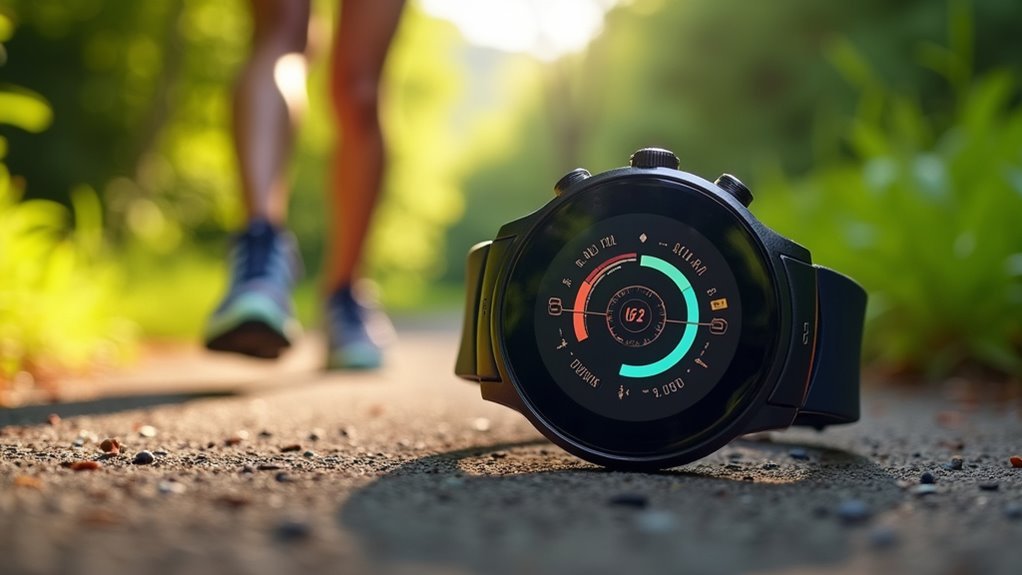You can calculate your Running Stress Score (RSS) today by using your watch’s power data with the formula: RSS/min = 0.0758 × exp(3.1297 × Power/CP), then multiplying by your total run duration. You’ll need your Critical Power (CP) value as the baseline – test this every 4-6 weeks with maximal efforts. Your RSS condenses workout stress into one detailed score that accounts for elevation changes and helps you understand training load. Master this calculation to reveal strategic training insights.
Understanding Running Stress Score Fundamentals

Your Critical Power serves as the reference point, ensuring stress scores reflect your individual capacity.
This power-based approach makes RSS specifically designed for running, unlike the more versatile Training Stress Score (TSS) that can use pace, heart rate, or power across different sports.
You’ll find RSS particularly valuable for day-to-day training evaluation, as it condenses your entire workout’s stress into one thorough score. The calculation incorporates normalized graded pace to account for elevation changes during your run.
Critical Power’s Role in RSS Accuracy
When calculating Running Stress Score, Critical Power acts as the essential baseline that determines whether your RSS accurately reflects your true training load.
Your CP represents the highest sustainable power you can maintain before fatigue becomes intolerable, functioning as the metabolic threshold that separates different exercise intensity domains.
Critical Power defines your metabolic threshold—the precise point where sustainable effort transitions into unsustainable intensity across all exercise domains.
RSS uses your power-to-CP ratio at each moment to quantify training stress. As your actual running power approaches or exceeds CP, your RSS increases accordingly.
However, inaccurate or outdated CP values will lead to incorrect RSS estimates, completely skewing your training load analysis.
You must maintain current CP data in your device profile and guarantee precise power measurements throughout each session.
Regular CP testing prevents underestimation or overestimation of your training stress and recovery needs. Testing should occur every 4-6 weeks to ensure your RSS calculations remain accurate as your fitness evolves.
RSS Formula Components and Variables

Understanding RSS calculation requires mastering its core mathematical components, which work together to translate your running power data into meaningful training stress values.
The fundamental RSS formula follows an exponential structure: RSS/min = A × exp(B × Power/Cp). You’ll work with two key parameters: A = 0.0758 and B = 3.1297, though you might need to adjust these based on your individual characteristics.
Your critical power (Cp) serves as the benchmark for sustainable effort, while your actual power output drives the exponential function. This creates a non-linear relationship where stress increases dramatically as power approaches your critical threshold.
You’ll also need your run’s total duration to calculate overall stress. If you don’t have direct power measurement, you can estimate power using pace data or GPS information. Manual calculation allows you to assess training stress without relying on expensive subscription services or premium platforms.
Power Data Collection Requirements
Accurate RSS calculations depend entirely on reliable power data, making your choice of power meter and collection methodology critical to meaningful training stress analysis.
You’ll need a device that’s compatible with your existing watch or app ecosystem while remaining lightweight enough to avoid altering your natural running form. Confirm your power meter supports wireless transmission via ANT+ or Bluetooth, and pair it properly with your primary training device before each run.
Set your sample rate to at least 1Hz and complete calibration checks during your start-up routine.
During runs, maintain consistent device placement and avoid pausing unnecessarily. Monitor for suspicious power spikes or drops, and always sync your data immediately post-workout to prevent corruption or loss. Software like WKO+ can automate TSS calculations using your collected power data, eliminating the need for manual estimation methods.
Calculating RSS Using Your Running Watch

While most modern running watches can’t calculate true RSS without an external power meter, they’ll serve as your central hub for collecting and processing the data needed for accurate stress scoring.
Your watch becomes invaluable when you:
- Enable data sharing and sync with apps like Garmin Connect or TrainingPeaks
- Update critical settings including your Functional Threshold Pace or Critical Power
- Calibrate sensors consistently for reliable measurements
- Sync data after each run to maintain accurate training load tracking
- Use compatible software that automatically processes RSS or rTSS calculations
Watches from Garmin, Coros, and Polar excel at gathering pace and heart rate metrics through integrated sensors.
When paired with power meters like Stryd, they’ll directly calculate running power for true RSS accuracy. Your watch’s internal algorithms process this real-time data to estimate effort and intensity effectively.
The RSS calculations utilize an exponential model that shows stress scores increase rapidly at higher intensities, making precise power measurement essential for accurate training load assessment.
RSS Vs Training Stress Score Differences
Though RSS and TSS both quantify training load through single numerical scores, they’re designed for different sports and use distinct approaches to measure workout stress.
RSS and TSS deliver single-number training load scores but target different sports with unique stress measurement approaches.
TSS, primarily for cycling, uses normalized power and functional threshold power (FTP) in its calculation. RSS specifically targets running and incorporates running power with Critical Power (CP) as your threshold reference.
The key difference lies in RSS’s higher coefficient (K value), which accounts for running’s greater mechanical stress on your body.
While TSS emphasizes aerobic and metabolic demands, RSS captures the unique impact of ground contact forces and muscular load from running. TSS accounts for both duration and intensity to provide athletes with a comprehensive understanding of their workout’s physiological cost.
Both benchmark an hour at threshold as 100 points, but RSS’s formula better reflects running-specific physiological costs and injury risks.
Threshold Metrics Impact on Stress Calculations
Your threshold values directly determine how accurately your running stress scores reflect actual training load.
When your functional threshold pace changes due to fitness gains or losses, it shifts all subsequent stress calculations until you update the baseline.
Maintaining consistent and current threshold data guarantees your stress scores remain meaningful for tracking training progress and recovery needs.
This precision enables quantitative assessment of multi-week training plans and helps identify optimal workload progression patterns.
Critical Power Accuracy Matters
Because Critical Power serves as the foundation for all Running Stress Score calculations, even small inaccuracies in this threshold metric can dramatically skew your training data.
When your Critical Power measurement is off, you’ll find yourself comparing RSS values that aren’t truly comparable across workouts.
To guarantee maximum accuracy in your Critical Power calculations, focus on these key elements:
- Incorporate diverse training data spanning 90 days with various run types including sprints and long runs
- Perform maximal effort runs at different durations (3-12 minutes) or distances (1000m, 3000m)
- Test every two to three months to maintain precision as your fitness evolves
- Use multiple maximal efforts rather than relying on just two minimum attempts
- Consider manual inputs for greater control over your Critical Power settings
Remember that Critical Power represents your maximum metabolic effort for approximately 40 minutes, making it a crucial benchmark for determining your optimal training intensities.
Threshold Changes Affect Scores
When your threshold values shift—whether from improved fitness, fatigue, or environmental factors—your Running Stress Score calculations automatically recalibrate to reflect these changes.
This recalibration creates a domino effect across your training data. If your Critical Power increases by 10 watts, yesterday’s workout will suddenly appear less stressful than it felt at the time. Conversely, if your threshold drops due to illness or overtraining, recent sessions will register higher stress scores retrospectively.
These adjustments aren’t just numerical—they’re essential for accurate training planning. Running uses rTSS calculations that differ fundamentally from cycling metrics, requiring specific pace and elevation data for proper assessment.
You’ll notice seasonal fluctuations affecting your scores as your fitness evolves. The system’s ability to adapt guarantees your RSS remains relevant to your current capabilities, making workout comparisons more meaningful across different training phases.
Consistent Data Ensures Precision
While threshold adjustments recalibrate your scores automatically, the precision of these calculations depends entirely on consistent data collection methods.
You’ll achieve the most accurate Running Training Stress Scores when you maintain uniformity in your approach.
Your data consistency directly impacts calculation reliability through several key factors:
- Use the same device or method for each workout to reduce variability in intensity factor measurements
- Stick with one metric type (pace vs. power) rather than switching between collection methods
- Exclude non-moving time from workout duration to guarantee calculations reflect actual exertion periods
- Apply Normalized Graded Pace consistently to account for terrain changes and environmental factors
- Record RPE at consistent times since your perceived exertion varies with mood and timing
This systematic approach eliminates variables that compromise your stress score accuracy.
Remember that TSS calculations assume you’re starting each workout fresh, but accumulated fatigue from previous sessions affects your actual stress level even when maintaining identical power or pace outputs.
Second-by-Second RSS Analysis Benefits
As your watch captures each second of your run, RSS analysis transforms raw data into actionable insights that reveal the true story of your effort.
You’ll detect subtle intensity shifts that overall averages miss, allowing precise mid-run adjustments and post-session prescriptions. This granular approach captures true training demand without losing critical details to zone averaging.
Your personalized feedback adapts to fluctuations in fitness and fatigue, supporting individualized pacing strategies.
Adaptive analytics respond to your body’s daily variations, delivering tailored pacing guidance that evolves with your changing performance capacity.
You’ll identify erratic effort spikes that signal injury risk and correlate stress peaks with post-run soreness.
Second-by-second analysis enables robust longitudinal tracking, comparing sessions at the millisecond level while detecting gradual training load changes across microcycles and macrocycles for research-based methodology adjustments. Power provides better guidance for training decisions than traditional pace or heart rate metrics across varying terrains.
Optimizing Training Plans With RSS Data
Beyond simply collecting data, RSS transforms how you structure and execute your training by providing the quantitative foundation needed for intelligent periodization.
You’ll move from guesswork to precision when planning weekly and monthly training blocks.
RSS enables you to:
- Set specific load targets for each training phase, matching stress to your fitness goals
- Track cumulative stress trends through Performance Management Charts to optimize timing
- Balance hard and easy days objectively, preventing random load cycles that derail progress
- Adjust workouts mid-block based on current RSS totals and recovery status
- Communicate effectively with coaches using shared RSS data for evidence-based training decisions
This quantitative approach reduces your risk of overreaching while ensuring you hit target fitness levels when it matters most for peak performance. Recovery time varies significantly based on individual factors like age, nutrition quality, lifestyle choices, and sleep patterns, making personalized stress monitoring essential for optimal training adaptation.
Preventing Overtraining Through RSS Monitoring
You’ll prevent overtraining by recognizing RSS threshold warning signs before they become performance-limiting problems.
Managing your daily training load through RSS data helps you balance stress and recovery in real-time.
You can optimize recovery time by tracking RSS patterns and adjusting rest periods based on your accumulated training stress. Early identification prevents the weeks or months of complete rest that full overtraining recovery requires.
RSS Threshold Warning Signs
Multiple warning signs can alert you to dangerous RSS threshold breaches before overtraining derails your progress.
Your body provides clear signals when you’re pushing beyond sustainable limits, and recognizing these patterns helps prevent serious setbacks.
Watch for these critical indicators:
- Elevated resting heart rate – Your morning pulse stays consistently higher than baseline, signaling chronic stress accumulation.
- Persistent heavy legs – That achy, sluggish feeling won’t disappear despite rest days and recovery efforts.
- Mental burnout – Running feels like a chore instead of something you enjoy, and motivation completely vanishes.
- Incomplete recovery – You’re still fatigued the day after medium RSS sessions (150-300) or need extended recovery after high RSS workouts.
- Performance plateaus – Your times stagnate or worsen despite maintaining consistent training effort and volume. When workouts consistently feel more difficult rather than easier over time, this indicates your training intensity may exceed your body’s adaptation capacity.
Daily Load Management Strategies
When you consistently monitor your RSS alongside daily wellness markers, you can catch overtraining patterns before they become serious problems.
Track your mood, sleep quality, soreness, and fatigue levels each morning using a simple questionnaire. If these indicators show negative trends while your RSS remains high, immediately reduce your daily training load by 40-50% for 7-10 days.
When wellness markers are positive, you can safely increase weekly training load by 4-5%, following the standard 10% rule maximum.
Replace hard sessions with easy runs when signs of overreaching appear, and avoid drastic intensity changes in either direction. Professional guidance from a physiotherapist or coach can help you interpret these patterns and adjust your training accordingly.
Keep detailed records of your daily RSS, wellness data, and performance metrics. This creates a baseline for identifying deviations and enables quick interventions before overtraining develops.
Recovery Time Optimization
Beyond tracking your daily wellness markers, you can leverage RSS data to optimize your recovery timing and prevent overtraining before it derails your progress.
RSS captures both volume and intensity, giving you objective insight into your accumulated stress rather than relying on subjective feelings alone.
Here’s how RSS helps prevent overtraining:
- Monitor sudden spikes – Sharp RSS increases signal immediate need for extra recovery time
- Compare against baseline – Tracking RSS trends reveals early overtraining patterns before symptoms appear
- Plan deload weeks – Schedule recovery blocks after consecutive high-RSS training periods
- Tailor recovery strategies – Match active or passive recovery to your specific RSS accumulation
- Schedule rest days – Use quantified stress data to time days off strategically
The cumulative stress from multiple workouts builds up over time, making it essential to recognize when your body needs extended recovery periods to maintain peak performance levels.
Improving Performance Using RSS Insights
Since RSS quantifies your training stress through a precise combination of volume and intensity, you can leverage these insights to make targeted adjustments that enhance your running performance.
You’ll gain objective feedback on your recovery needs, helping you schedule rest or low-stress sessions at ideal times. This data-driven approach enables incremental workload increases while minimizing injury risk through progressive overload management.
RSS provides quantifiable methods to tailor training volume and intensity to your individual capabilities and goals.
By aligning training intensity with your RSS scores, you can target specific physiological systems for precise adaptations.
You’ll identify overreaching patterns before they lead to burnout, and you can refine your training sessions by evaluating the stress-versus-recovery balance for maximum performance gains.
Frequently Asked Questions
Can I Calculate RSS Without a Power Meter or Stryd Pod?
You can’t calculate RSS without a power meter or Stryd pod since it requires precise power data and Critical Power. You’ll need alternative metrics like TRIMP, rTSS, or heart rate-based methods instead.
How Does Weather Conditions Affect My Running Stress Score Calculations?
Weather conditions directly impact your running stress score by affecting your heart rate, pace, and perceived exertion. Heat increases cardiovascular stress, while cold reduces efficiency, requiring adjustments to accurately reflect your true training load.
What’s the Minimum Workout Duration Needed for Accurate RSS Measurements?
You don’t need a strict minimum duration for accurate RSS measurements, but workouts longer than 15-20 minutes provide more reliable stress scores since they better reflect your sustained power output patterns.
Does Body Weight Changes Require Recalibrating My RSS Baseline Settings?
You don’t need to recalibrate RSS baseline settings for body weight changes. Instead, update your device’s weight setting between training cycles, not mid-season, to maintain consistent RSS comparability.
Can RSS Be Calculated for Treadmill Runs or Indoor Workouts?
You can calculate RSS for treadmill runs using power meters like Stryd pods. Without power data, you’ll need heart rate zones for estimates, though this won’t be as accurate as power-based calculations.
In Summary
You’ve now got the tools to calculate your running stress score and transform your training approach. Start collecting power data from your runs, determine your critical power threshold, and apply the RSS formula consistently. Monitor your scores daily to prevent overtraining while identifying opportunities to push harder. Your running watch becomes a powerful ally when you’re tracking second-by-second data and making informed decisions about your training intensity and recovery needs.





Leave a Reply